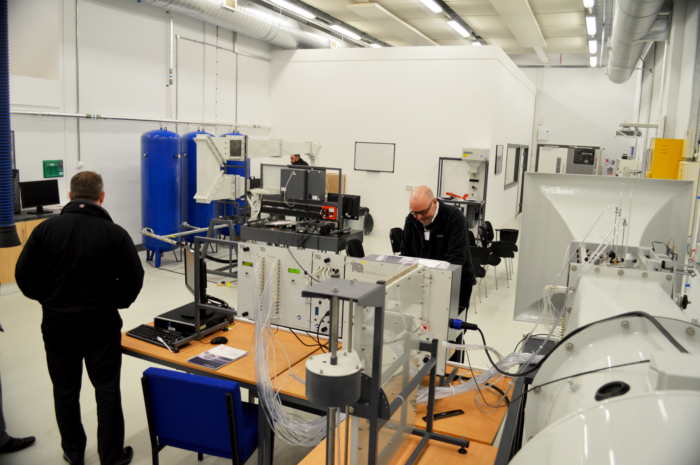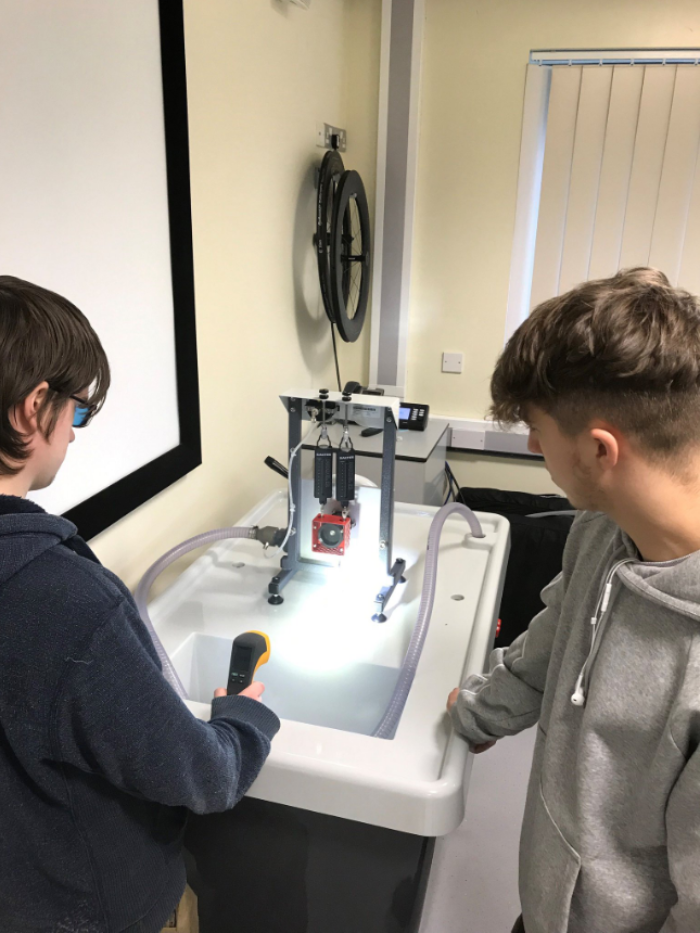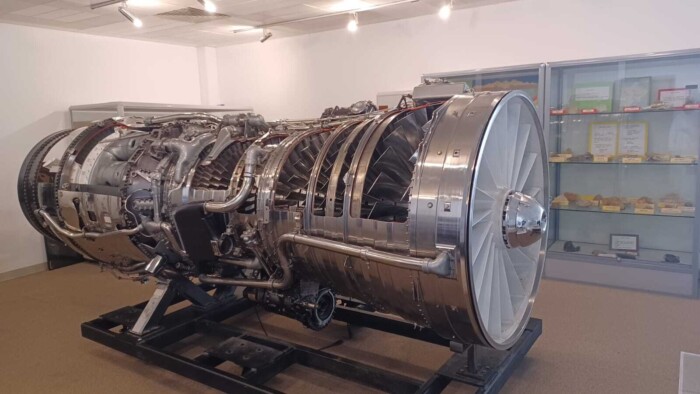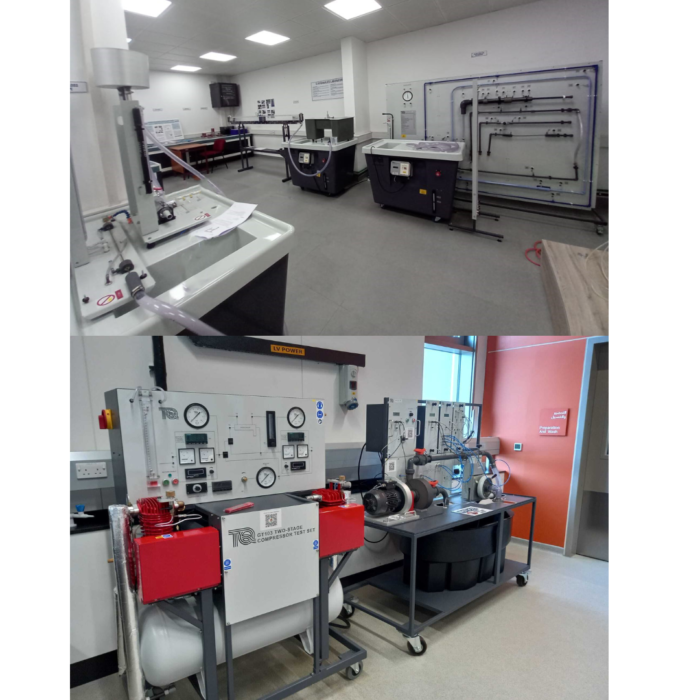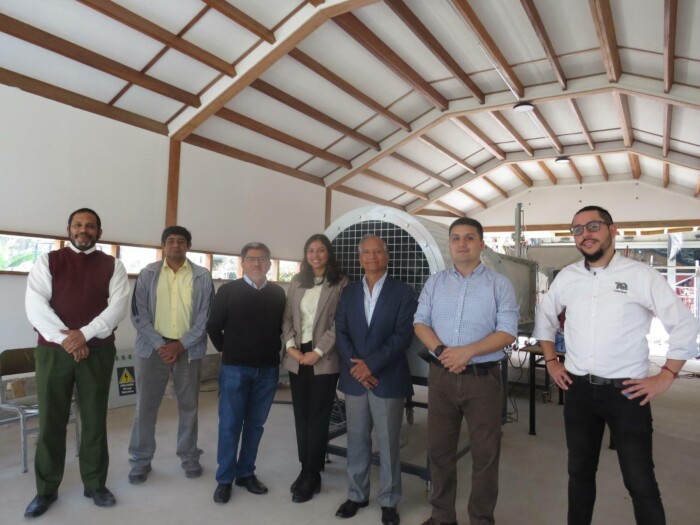M
Mach Number: The ratio between the speed of a body and the speed of sound in a specific area. Often referred to (Mach 1, Mach 2 etc), to indicate speed of sound and twice the speed of sound.
Manometer: An instrument for measuring the pressure of a fluid. It consists of a tube filled with liquid and the level of liquid is determined by the fluid pressure.
Marcet Boiler: A boiler to help investigate the relationship between pressure and temperature of saturated steam in different temperatures of water.
Mechanical Advantage: is a measure of the force amplification achieved by using a tool, mechanical device, or machine system. The device trades off input forces against movement to obtain a desired amplification in the output force. The model for this is the law of the lever
Mechanical Toggle: The toggle mechanism is made of two arms linked together. Point 1 is fixed, point 3 can move horizontally. The effort force acts vertically in point 2.

Metacentric Height (GM): is a measurement of the initial static stability of a floating body. It is calculated as the distance between the centre of gravity of a ship and its metacentre. A larger metacentric height implies greater initial stability against overturning. The metacentric height also influences the natural period of rolling of a hull, with very large metacentric heights being associated with shorter periods of roll which are uncomfortable for passengers.
Modulus of Rigidity: Also known of Shear modulus. A formula to show the material property with a value which is equal to the shear stress divided by the shear strain.
Mohr’s Circle: a graphical representation of the transformation equations for plane stress problems. It is useful in visualizing the relationships between normal and shear stresses acting on a stress element at any desired orientation.

Moment of Inertia: The moment of inertia, otherwise known as the mass moment of inertia, angular mass, second moment of mass, or most accurately, rotational inertia, of a rigid body is a quantity that determines the torque needed for a desired angular acceleration about a rotational axis, akin to how mass determines the force needed for a desired acceleration. It depends on the body's mass distribution and the axis chosen, with larger moments requiring more torque to change the body's rate of rotation.
Momentum Equation: In Newtonian mechanics, linear momentum, translational momentum, or simply momentum (pl. momenta) is the product of the mass and velocity of an object. It is a vector quantity, possessing a magnitude and a direction. If m is an object's mass and v is its velocity (also a vector quantity), then the object's momentum is 𝐩=m𝐯. In SI units, momentum is measured in kilogram meters per second (kg⋅m/s).
Momentum Flux: The momentum rate changes the flow rate through a unit area.
N
Nusselt Number: In fluid dynamics, the Nusselt number (Nu) is the ratio of convective to conductive heat transfer at a boundary in a fluid. Convection includes both advection (fluid motion) and diffusion (conduction). The conductive component is measured under the same conditions as the convective but for a hypothetically motionless fluid.
Neutral Axis: The neutral axis is an axis in the cross section of a beam (a member resisting bending) or shaft along which there are no longitudinal stresses or strains. If the section is symmetric, isotropic and is not curved before a bend occurs, then the neutral axis is at the geometric centroid. All fibres on one side of the neutral axis are in a state of tension, while those on the opposite side are in compression.
O
Oscillations: Vibrations going back and forth in a regular rhythm.
Oscilloscope: A device for viewing oscillations to help measure the waveforms of electronic signals.
P
Particle Suspension: A suspension is a heterogeneous mixture in which some of the particles settle out of the mixture upon standing. The particles in a suspension are far larger than those of a solution, so gravity can pull them down out of the dispersion medium (water).
Pantograph: is a mechanical linkage connected in a manner based on parallelograms so that the movement of one pen, in tracing an image, produces identical movements in a second pen. If a line drawing is traced by the first point, an identical, enlarged, or miniaturized copy will be drawn by a pen fixed to the other. Using the same principle, different kinds of pantographs are used for other forms of duplication in areas such as sculpture, minting, engraving, and milling.
Peaucellier-Lipkin (linkage): named after Charles-Nicolas Peaucellier and Yom Tov Lipman Lipkin after its invention int 1864. It was the first true planar straight-line mechanism – the first planar linkage capable of transforming rotary motion into perfect straight-line motion, and vice versa.
Photovoltaic Cells: A specialised semiconductor diode which converts visible light into a direct current.
Phugoid Motion: A phugoid or fugoid is an aircraft motion in which the vehicle pitches up and climbs, and then pitches down and descends, accompanied by speeding up and slowing down as it goes "downhill" and "uphill". This is one of the basic flight dynamics modes of an aircraft (others include short period, roll subsidence, dutch roll, and spiral divergence), and is a classic example of a negative feedback system.
Pitching Moment: In aerodynamics, the pitching moment on an aerofoil is the moment (or torque) produced by the aerodynamic force on the aerofoil if that aerodynamic force is applied, not at the centre of pressure, but at the aerodynamic centre of the aerofoil.
Pitot-Static Flow Meter: A flow measurement device to measure fluid flow velocity in many fluid mechanics products.
Elastic Region: The region of the stress-strain curve in which the material returns to the undeformed state when applied forces are removed is called the elastic region.
Plastic Region: The region in which the material deforms permanently is called the plastic region.
Poisson’s Ratio: A ratio showing the proportional decrease in the lateral measurement of a long piece of sample material that is stretched elastically.
Poiseuille Flow: The law of Poiseuille states that the flow of liquid depends on the following variables such as the length of the tube(L), radius (r), pressure gradient (∆P) and the viscosity of the fluid (η) in accordance with their relationship. The Poiseuille’s Law formula is given by: Q = ΔPπr4 / 8ηl
Polar Moment of Inertia: also known as second (polar) moment of area, is a quantity used to describe resistance to torsional deformation (deflection), in cylindrical objects (or segments of cylindrical object) with an invariant cross-section and no significant warping or out-of-plane deformation. It is a constituent of the second moment of area, linked through the perpendicular axis theorem.
Pole Zero: A pole-zero plot shows the location in the complex plane of the poles and zeros of the transfer function of a dynamic system, such as a controller, compensator, sensor, equalizer, filter, or communications channel. By convention, the poles of the system are indicated in the plot by an X while the zeros are indicated by a circle or O.
Polytropic Process: A polytropic process is a thermodynamic process that obeys the relation: pV ⁿ=C where p is the pressure, V is volume, n is the polytropic index, and C is a constant. The polytropic process equation can describe multiple expansion and compression processes which include heat transfer.
Pressure Gradient: In atmospheric science, the pressure gradient (typically of air but more generally of any fluid) is a physical quantity that describes in which direction and at what rate the pressure increases the most rapidly around a particular location. The pressure gradient is a dimensional quantity expressed in units of pascals per metre (Pa/m). Mathematically, it is the gradient of pressure as a function of position. The negative gradient of pressure is known as the force density.
Pulley: The wheel on an axle or shaft that is designed to support movement and change of direction of a cable or belt to help transfer power.
Pump:
Axial: Most common pump used for understanding the inflow for suction happens parallel to the axis of rotation of the impeller.
Centrifugal: A pump which uses rotations to move water and other fluids.
Piston: A positive displacement pump where the high-pressure seal reciprocates with the piston. Mainly used to move liquids or compress gases.
Vane: A positive-displacement pump which consists of vanes mounted to a rotor which then rotates inside a cavity.
Psychrometric Processes/Charts: A psychrometric chart presents physical and thermal properties of moist air in a graphical form.
Q
R
Radial Pressure Distribution: the probability distribution to find the centre of a particle in a given position at a radial distance r from the centre of a reference sphere.

Rayleigh–Jeans Law: an approximation to the spectral radiance of electromagnetic radiation as a function of wavelength from a black body at a given temperature through classical arguments. For wavelength.
Reynolds Number: The ratio of inertial forces to viscous forces within a fluid which is subjected to relative internal movement due to different fluid velocities.
Rockwell Hardness Test: A test to show the hardness of a metal or alloy measured by an apparatus in which a diamond pointed cone is pressed into the metal to a standard depth to determine the relative resistance to penetration as indicated by a dial.
Rotational Flow: A flow is rotational if fluid elements undergo rotation about their axis while flowing along streamlines. The flow is rotational when its vorticity vector is non-zero in some of its regions.
Robert and Hoeken’s (linkage):
The Hoecken linkage: Is a four-bar linkage that converts rotational motion to approximate straight-line motion. It is named after Karl Hoecken.
The Roberts linkage: is a four-bar linkage which converts a rotational motion to approximate straight line motion.
R Value: An R-value is, in short, a number that tells you how good a material is at resisting the flow of heat. If it resists the flow of heat well (has a high r-value) then it’s a good insulating material. For the purposes of insulating a building then the higher the R-value, the better.
––––––––––––––––––––––––––––––––––––––––––––
We hope you found this glossary of terms helpful in aiding your learning, to move onto the next section of our Mechanical and Civil engineering principles glossary S-Z follow the link here!





